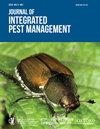Thrips in genus Megalurothrips (Thysanoptera: Thripidae): biodiversity, bioecology, and IPM
IF 2.7
3区 农林科学
Q1 ENTOMOLOGY
引用次数: 1
Abstract
Currently, there are a total of 15 thrips species in the genus Megalurothrips (Thysanoptera: Thripidae). Megalurothrips sjostedti Trybom and Megalurothrips usitatus (Bagnall) are the most economically important pest species because of the serious damage they can do to leguminous crops, especially cowpea, which is an important grain crop for Africa and a vegetable crop for the rest of the world. Megalurothrips sjostedti is only distributed in Africa, while M. usitatus is widely spread in subtropical and tropical regions of the world and is more invasive. Nigeria is the only area where both thrips species are shared. Inexplicably, M. usitatus does not seriously damage cowpea in Africa. Bioecological characteristics indicated that M. usitatus adapts to a wider temperature and humidity range, which may result in its current geographic distribution. Since the 2010s, M. usitatus has received more attention and research. The integrated pest management (IPM) strategy of both thrips as case studies was reviewed in this paper, along with multiple complementary tactics, including agronomic measures, physical-chemical lure control, biological control, and chemical control, and insecticide resistance. Lessons have been learned from both M. sjostedti and M. usitatus, as well as from another widespread invasive thrips species, Frankliniella occidentalis (Pergande) (Thysanoptera: Thripidae), thus enhancing our overall understanding of the biology, ecology, and IPM practices of M. sjostedti and M. usitatus.大尾蓟马属的蓟马(蓟翅目:蓟科):生物多样性、生物生态学和IPM
目前,大尿蓟马属共有15种(蓟翅目:Thripidae)。大尿蓟马和大尿蓟马(Bagnall)是经济上最重要的害虫,因为它们可以对豆科作物,特别是豇豆造成严重损害,豇豆是非洲重要的粮食作物和世界其他地区的蔬菜作物。大尾蓟马仅分布于非洲,而大尾蓟马在世界亚热带和热带地区广泛分布,具有较强的入侵性。尼日利亚是唯一一个两种蓟马共有的地区。令人费解的是,M. usitatus对非洲豇豆的危害并不严重。生物生态学特征表明,紫杉适应较宽的温度和湿度范围,这可能是其目前地理分布的原因。自2010年代以来,M. usitatus得到了更多的关注和研究。以这两种蓟马为例,综述了其综合防治策略,并结合农艺措施、物化诱防、生物防、化学防、抗虫等多种辅助策略。本文从sjostedti和M. usitatus以及另一种广泛存在的入侵蓟马物种Frankliniella occidentalis (Pergande) (Thysanoptera: Thripidae)中吸取了经验教训,从而提高了我们对M. sjostedti和M. usitatus的生物学、生态学和IPM实践的整体认识。
本文章由计算机程序翻译,如有差异,请以英文原文为准。
求助全文
约1分钟内获得全文
求助全文
来源期刊

Journal of Integrated Pest Management
Agricultural and Biological Sciences-Insect Science
CiteScore
5.80
自引率
3.60%
发文量
24
审稿时长
25 weeks
期刊介绍:
Journal of Integrated Pest Management is an open access, peer-reviewed, extension journal covering the field of integrated pest management. The Editors-in-Chief are Dr. Marlin E. Rice (formerly with Iowa State University) and Dr. Kevin L. Steffey (formerly with the University of Illinois). The journal is multi-disciplinary in scope, publishing articles in all pest management disciplines, including entomology, nematology, plant pathology, weed science, and other subject areas.
 求助内容:
求助内容: 应助结果提醒方式:
应助结果提醒方式:


